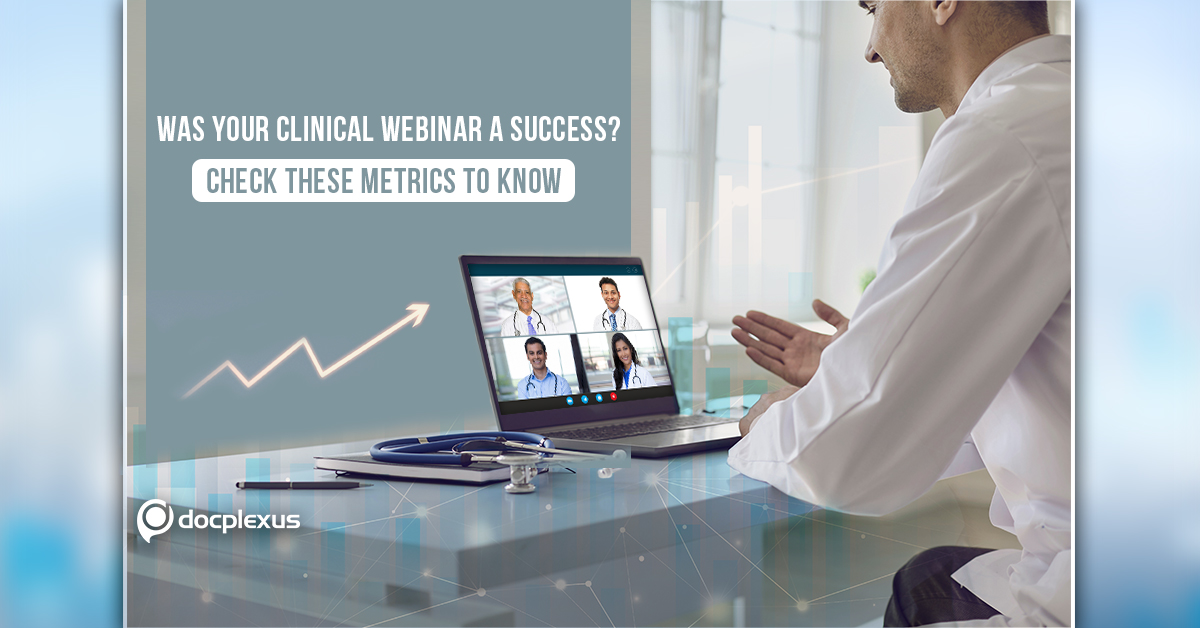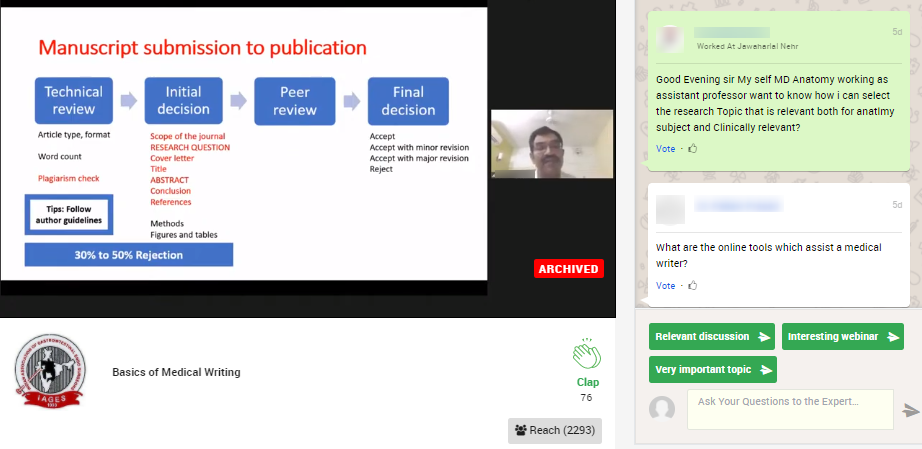
Webinars have seen the growing dependence of the Healthcare Industry for HCP and KOL engagement, due to increased virtual interactions in the ongoing pandemic.
Whether you see Webinar as a business solution or a channel for clinical conversations/discussions – tracking the performance metrics is of absolute importance. In this write-up, we will look into some “Key Webinar Metrics”.
Broadly, you can divide the performance of your clinical webinar into three categories, namely:
i)Reach
ii) Engagement
iii) Feedback
Let’s understand their significance one by one.
Reach
i) Reaching out to the right audience–These are the people that comprise your primary target audience (HCPs, KOLs, Medical Associations, etc.). They need to be intimated prior to the Webinar, preferably a week before the session, using channels like Emails, SMSes, WhatsApp, etc.
Tip – A reminder email or SMS can be sent to people who either opened your invitation or clicked the CTA.
ii) Number of registrations received –The registrations received gives you an insight into whether you were successful in reaching out to the desired audience. That being said, we generally host open webinars on our platform and social media pages, and the HCPs can join the sessions directly after clicking the invitation links.
Tip – Consider this metric to recognize your high-intent participants. More people taking that extra effort and registering for the webinar indicates that you have rightly targeted your audience, and your topic is fresh and relevant.
iii) Number of attendees who join the live broadcast – Now this is what it all comes down to. It is always encouraging for panelists (KOLs, medical experts, etc) to address a large live audience and have an interactive Q & A session. If your webinars repeatedly attract a large number of live attendees, then it’s a reflection of your brand’s credibility. It shows that HCPs trust your content and are willing to schedule their time to participate in your webinar.
To get a good number, make sure that an automated email is triggered to every registered HCP (or to every invitee if there is an open webinar) the moment the discussion goes live. Some registered participants may still not join your webinar due to their “last minute” change of plans.
Tip – The timing of your webinar also matters, as it directly impacts attendance. We, for example, have seen high traffic on our platform between 9 to 11 AM or 5 to 7 PM on Saturdays, and between 2 to 5 PM or 6 to 8 PM on weekdays. So we time most of our webinars in these slots.
[mk_mini_callout title=”Digital Marketing Playbook For Pharma:” button_text=”Click Here” button_url=”http://docplexus-insights.com/blog/digital-transformation-in-pharma/social-listening-pharma-hcps/”]To read the other write-ups in this series[/mk_mini_callout]
iv) Number of attendees who see the recorded/archived session –In the case that your registered audience did not turn up for the live webinar due to any unforeseen reasons, you can still attract them by sharing the recorded or archived sessions, something our in-house digital marketing team does for our industry partners.
Tip – Put more emphasis on “Total Reach”, ie, “Number of views for the live session + Number of views for the recorded/archived session”
Engagement
i) View-Through-Rate (VTR) – VTR takes into consideration the attendees who watch the complete session. It rarely is the case that all your attendees sit through the entire webinar. But that’s rarely the case as “Drop-Offs” are always there. For example, if there were Y attendees at the 15th min and X attendees at the end of the session, then: VTR= (X/Y) x 100
ii) Drop-Off Rate – Due to multiple reasons, HCPs may lose interest and leave your session in the middle. You can find the number of “Drop-Offs” for different time intervals (1 – 5 mins, 5 – 10 mins, 30 mins – 60 mins, etc). When calculating this metric, it’s better to break your session into as many time intervals as possible. Having the right timestamps marked on your webinar along with the pre-communicated agenda helps in keeping the audience engaged as they know what to expect and when.
Possible reasons for the drop-offs:
o You didn’t market your webinar to the right audience (Therapeutic Areas weren’t mapped accurately)
o You didn’t communicate your webinar’s objectives with clarity.
o Your webinar lacked interactive elements (downloadable PDFs, PPTs, Likert Scale questions, etc.).
o There were connectivity issues.
o There was no proper lead-up to your Call to Action.
Tip – We conduct a detailed mindset analysis of our audience prior to the webinar to understand the pain points enabling us to tailor the content accordingly.
iii) Attendee Interest Rating – It gauges attendee’s interest (on a scale of 1-100) during the webinar, by considering factors like:
a) Attentiveness – The total time duration during which your webinar’s window is on the attendee’s screen.
b) Attendance Length –The average duration of one session (Session – When attendees continuously engage with the webinar for a particular time span).
iv) Number of comments/questions –The number and nature of questions shared by physicians/clinicians during the session indicate the quality of your overall presentation.
Make sure you include visual aids and downloadable material in your presentation, to help HCPs better understand your subject matter and ask specific questions.
Tip – You can mention FAQs related to the webinar’s topic or even use comment chips, for stoking clinical conversations among the participants. It will also increase the “Average Viewing Time” of your webinar.
The below screenshots clearly reflect the total reach as well as the robust comments section.
Feedback
i) Number of requests received –It reflects that the webinar was well appreciated if you are receiving similar or further requests from your attending audience. Sharing feedback forms at the end of every webinar can give you a deeper insight into the audience’s perception.
Tip – At the end of your webinar, you can share a Google Form (asking HCPs for their preferred mode of interaction with your sales team) along with downloadable infographics on patient journeys.
ii) Response to the Follow-up surveys –It is difficult to quantify how involved and curious HCPs were during the session, but still, follow-up surveys (having open-ended as well as Likert Scale questions)can give you a fair idea.
For example, if their answers are precise and insightful, then the purpose of your session was definitely served. If they suggest a few improvements for your future webinars, then even better.
Tip – Your sales team can later reach out to the participants personally and strike a conversation around the shared knowledge.
In the times of COVID-19, we have hosted 500+ multi-panel clinical webinars on Docplexus, in collaboration with our huge pool of 7000+ KOLs across specialties, 35+ Partner Medical Associations, and Global Associates. Our new-age crash-proof platform enables you to host a glitch-free webinar for a large audience. Our existing captive audience can be segmented on the basis of therapy areas giving clear actionable segments to be reached out in a targeted fashion enabling that the messaging reaches the right desired target audience.
If you are interested in knowing more about our Webinar Solution, feel free to reach us at priyanka.kumari@docplexus.in.

